ACRN has successfully received concept approval from TÜV SÜD Rail GmbH for its functional safety concept, design and management process in place. The concept approval letter claims that, “ACRN Hypervisor is able to fulfill the requirements in accordance with SIL 3 of the IEC 61508 standard.”
IEC 61508 is considered as the “Golden Standard” in the functional safety industry. ACRN is on track to receive the final functional safety certification by the end of 2020.
Read more in the Linux Foundation newsroom post, “The ACRN™ Open Source Hypervisor for IoT Development Announces ACRN v2.0 and Functional Safety Certification Concept Approval”
We are pleased to announce the release of ACRN™ Hypervisor version 1.6, which introduces a number of new features.
What’s new in v1.6
- Graphics pass-through support
- The hypervisor and Service VM support pass-through graphics device to target DM-launched guest VMs, based on GVT-d.
- SRIOV support
- The ACRN hypervisor allows an SRIOV-capable PCI device’s Physical Function (PF) to be allocated to the Service VM and its Virtual Functions (VFs) to be allocated to any VM.
- The ACRN Service VM supports an SRIOV ethernet device (through the PF driver) and ensures an SRIOV VF device can be assigned (pass-through) to a post-launched VM (launched by ACRN-DM).
- CPU sharing enhancement – Halt/Pause emulation
- For a vCPU using the fairness CPU scheduler, the hypervisor supports yielding an idle vCPU (when it’s running a ‘HLT’ or ‘PAUSE’ instruction).
- PCI Config space access emulation for Pass-thru devices in the hypervisor
- The hypervisor provides the necessary emulation (such as config space) of the pass-thru PCI device during runtime for a DM-launched VM. Such runtime emulation is DM-independent.
- PCI bridge emulation in the hypervisor
See the full release notes and latest documentation for more information about this 1.6 release.
Documentation updates
Many new reference documents are available, including:
- Security Advisory
- Using Xenomai as User VM OS (Real-Time VM)
- Split Device Model
- RDT Configuration
- SR-IOV Virtualization
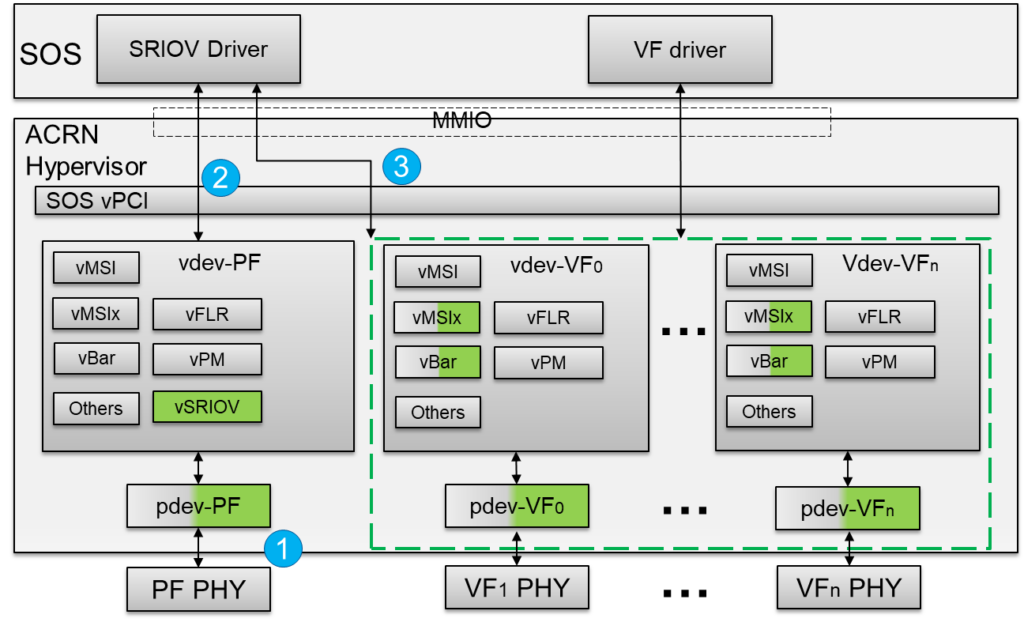
We recommend that all developers upgrade to ACRN release v1.6.
About the ACRN Project
ACRN is a flexible, lightweight reference hypervisor, built with real-time and safety-criticality in mind, optimized to streamline embedded development through an open source platform. To learn more, please visit https://projectacrn.org/.
About the Linux Foundation
Founded in 2000, the Linux Foundation is supported by more than 1,000 members and is the world’s leading home for collaboration on open source software, open standards, open data, and open hardware. Linux Foundation’s projects are critical to the world’s infrastructure including Linux, Kubernetes, Node.js, and more. The Linux Foundation’s methodology focuses on leveraging best practices and addressing the needs of contributors, users and solution providers to create sustainable models for open collaboration. For more information, please visit us at linuxfoundation.org.
Embedded World 2020 is a wrap. This year the ACRN hypervisor and Zephyr RTOS were demonstrated together in Canaonical’s Ubuntu booth.
Since ACRN’s start in 2018 as a Linux Foundation project, the ACRN team focused on developing a hypervisor that is flexible, lightweight, open-source, and built with real-time and safety-criticality in mind. The Zephyr RTOS, another Linux Foundation project, strives to deliver the best-in-class RTOS for connected, resource-constrained devices and is built to be secure and safe.
Canonical took advantage of this unique set of capabilities in open source projects by demonstrating single-system mixed workload consolidation based on Zephyr, Ubuntu, and ACRN. The Zephyr RTOS runs specialized tasks requiring real-time capabilities or integrating functional safety modules, while Ubuntu is the rich Linux operating system running other non-real-time workloads. The ACRN hypervisor provides the isolated virtual machine environment, concurrently supporting both workloads.
The architecture of Canonical’s demo is depicted below. The Zephyr RTOS is running in a pre-launched Virtual Machine (VM) completely isolated from Ubuntu, so any workload crash or even a reboot of the Ubuntu VM will not disturb the tasks running in Zephyr.
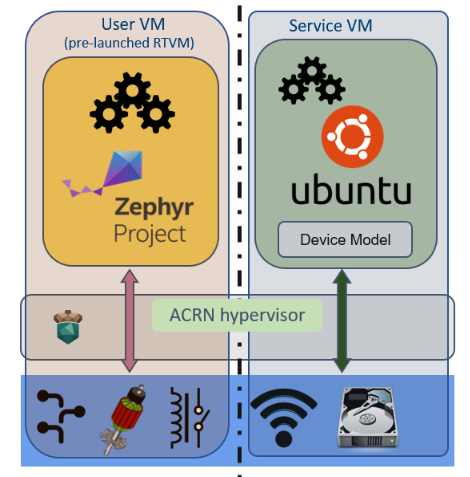
Visit Canonical’s blog for more details on their Embedded World 2020 demo.
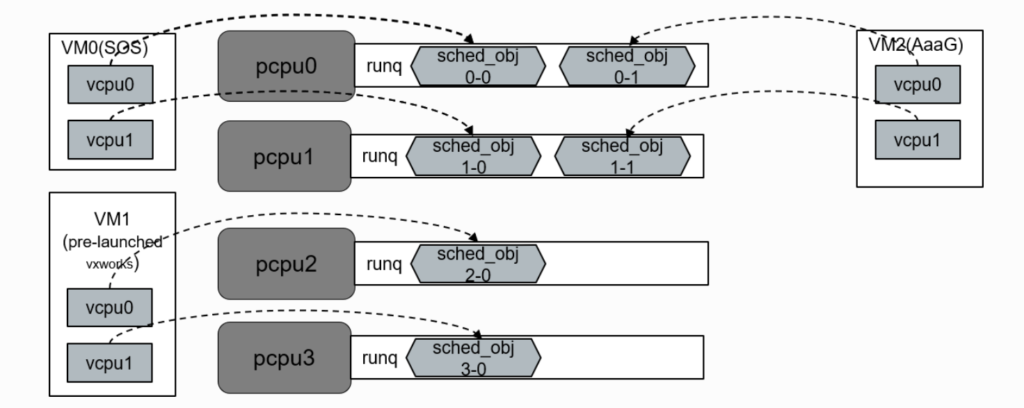
We are pleased to announce the release of ACRN™ Hypervisor version 1.5 which introduces a number of new features.
Version 1.5 major features
What’s New in v1.5
- Basic CPU sharing: Fairness Round-Robin CPU Scheduling has been added to support basic CPU sharing (the Service VM and WaaG share one CPU core).
- 8th Gen Intel® Core ™ Processors (code name Whiskey Lake) are now supported and validated.
- Overall stability and performance has been improved.
- An offline configuration tool has been created to help developers port ACRN to different hardware boards.
See the full release notes and latest documentation for more information about this 1.5 release.
Document updates
Many new reference documents are available, including:
- Run Kata Containers on a Service VM
- Supported Hardware (Addition of Whiskey Lake information)
- ACRN CPU Sharing
- Using Windows as Guest VM on ACRN (Update to use ACRNGT GOP to install Windows)

Refer to the ACRN version 1.5 release notes for more details.
About the ACRN™ Project
ACRN is a flexible, lightweight reference hypervisor, built with real-time and safety-criticality in mind, optimized to streamline embedded development through an open source platform. To learn more, please visit https://projectacrn.org/.
About the Linux Foundation
Founded in 2000, the Linux Foundation is supported by more than 1,000 members and is the world’s leading home for collaboration on open source software, open standards, open data, and open hardware. Linux Foundation’s projects are critical to the world’s infrastructure including Linux, Kubernetes, Node.js, and more. The Linux Foundation’s methodology focuses on leveraging best practices and addressing the needs of contributors, users and solution providers to create sustainable models for open collaboration. For more information, please visit us at linuxfoundation.org.

Can you believe December is almost gone? While many of us are looking forward to the holidays and time with our loved ones, December also brings a convenient occasion to look back on the year and check out what ACRN has achieved in 2019.

The first keyword in mind: Production – ACRN drives on the road!
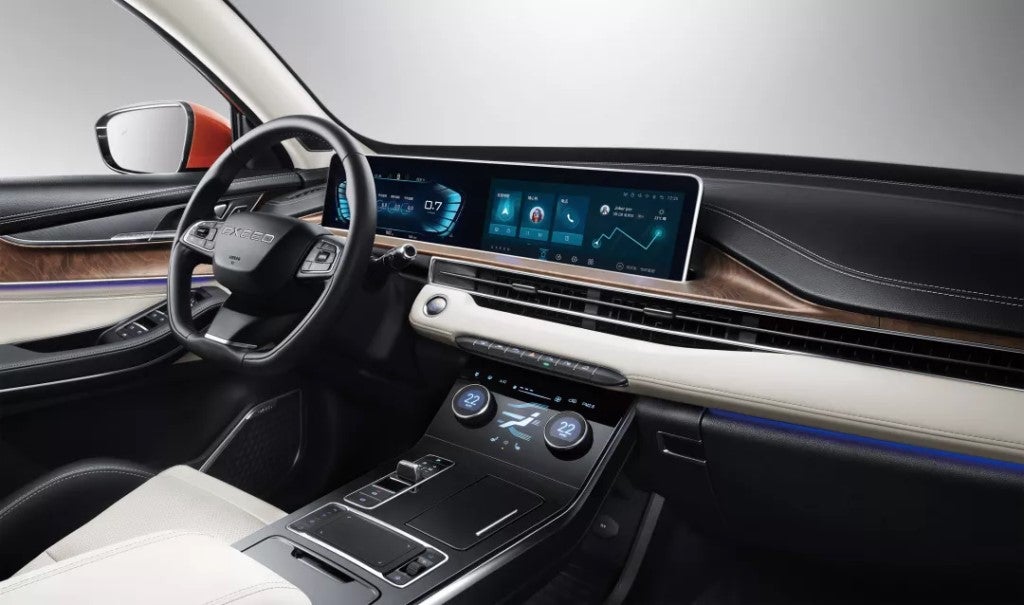
A new SUV based on ACRN, the EXEED-LX, was officially released by the Chinese car maker Chery in Q3’19. It features the eye-catching dual 12.3-inch floating LCD screen, a newly designed electronic instrument cluster, a facial recognition system that automatically adjusts the interior settings customized for the driver, and an AR-enhanced real-life navigation system that gets you where you need to go. These applications are made possible by adopting Intel’s Apollo Lake processor and the ACRN™ virtualization solution.
The ACRN hypervisor builds a virtual layer on top of the underlying hardware processor, achieving multi-OS workload consolidation to ensure isolation and non-interference between the electronic instrument cluster and the infotainment system. ACRN supports fast start-up, enabling the rapid display of cluster dashboards. ACRN also supports the underlying hardware resource sharing, where a single, physical graphics card can simultaneously display the UI of the instrument cluster dashboard and the IVI system. It similarly supports shared storage devices, shared network interface controllers, and shared sound cards.
Congratulations to Chery*, Neusoft* and Intel teams for making this happen. The ACRN project really appreciates your seamless collaboration!
ACRN targets two main scenarios: SDC and Industrial Workload Consolidation
ACRN is a flexible, lightweight reference hypervisor, built with real-time and safety-criticality in mind, optimized to streamline embedded development through an open source platform and implemented in less than 40K lines of code.
Now that the Software Defined Cockpit (SDC) scenario is complete, ACRN is devoting its resources in a more challenging realm: Industrial Workload Consolidation. These features are still in development but show great promise:
- Guest Windows runs well on ACRN as a Human-Machine Interface (HMI)
- Guest Real-time OS (RTOS) achieves near-to-native performance
- Function Safety development for partition mode is proceeding according to plan.
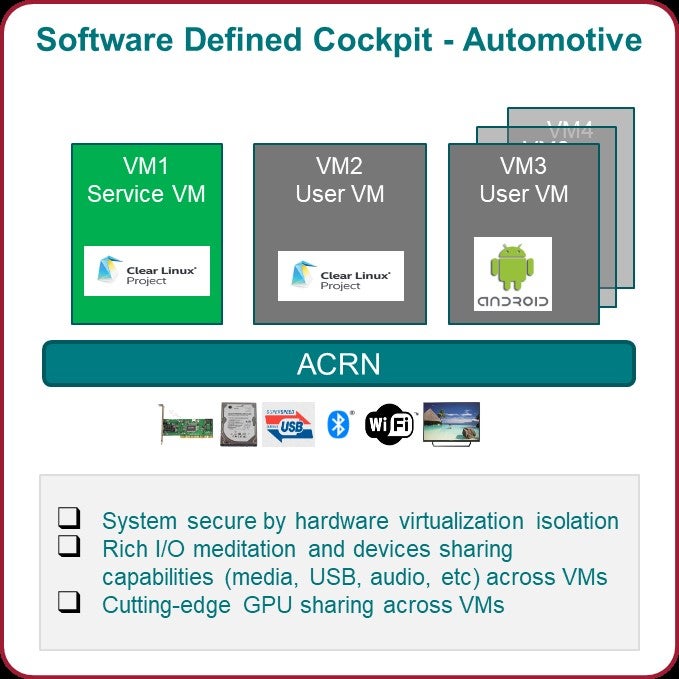
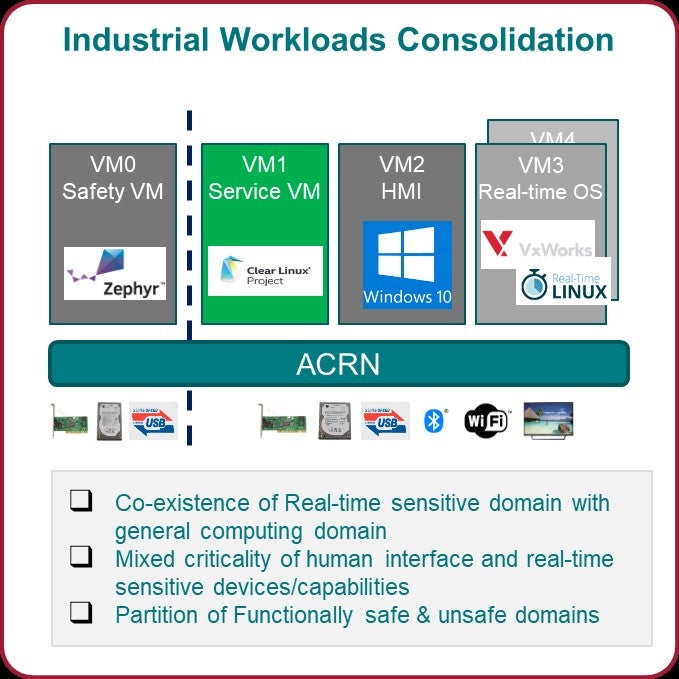
With contributions from the community, ACRN hosted an IoT seminar in Shanghai
The 1st Open Source IoT Projects Seminar was held on June in Shanghai. This was the first time that the ACRN project ran a community seminar with a focus on promoting open source projects in the IoT arena. Themed ‘Open Source Drives IoT, From Device to Edge’, the seminar was sponsored through collaboration between ACRN, Celadon, AliOS, Clear Linux, ROS 2, StarlingX and Zephyr projects. The seminar covered a wide spectrum of technologies, from virtualization, real-time, security and safely, to industrial real-time workload consolidation, IVI, automotive, drones, robotic, retail and other technologies which enable numerous IoT innovations.
The seminar featured 30 technical speeches, 13 demos and 4 hands-on/workshops. It was attended by 161 community developers, software engineers, and technical managers from key partners and customers.
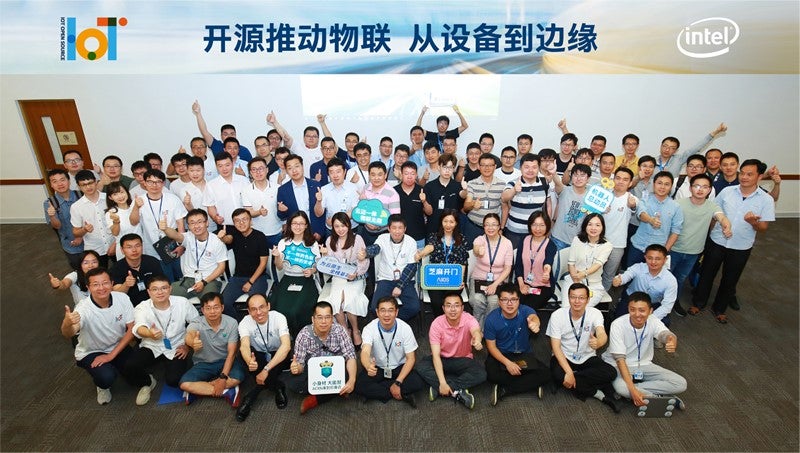
The ACRN community is becoming stronger
- 8 ACRNiterative versions were released, from v0.5 to the latest v1.4
- 22 worldwide conference events, demos and promotions by ACRN
- 46 Technical Community Meetings, spanning architecture design, implementation, tools, and developer experiences
- 424 subscribers of ACRN community mailing list
- 4,554 commits (as of Dec. 14th, 2019)
- 100
contributors have submitted patches for ACRN.
- Congratulations to the top 4 developers:
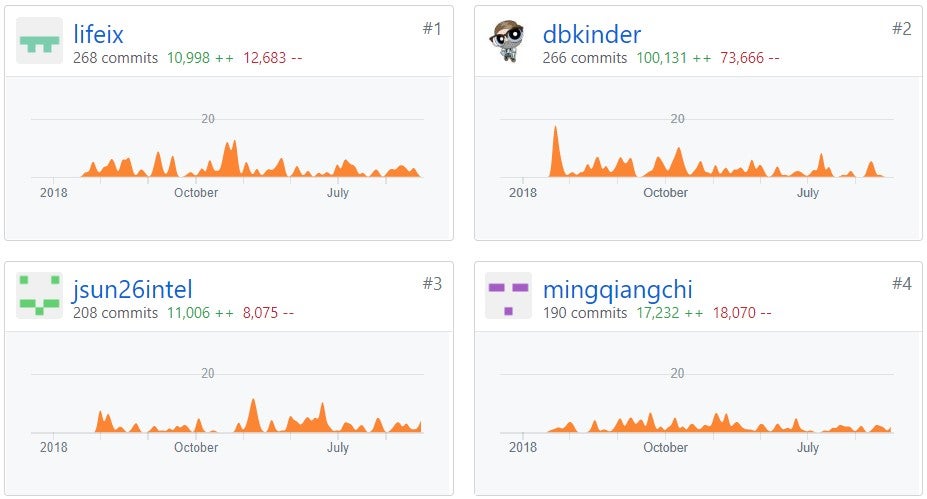
- 1,933 followers to ACRN WeChat account, 48 original blogs posted, total engagement >20K, 645 members joined ‘ACRN Developer Technical Group’ on WeChat
- 254 Twitter followers, 54 Facebook followers
About the ACRN™ Project
ACRN is a flexible, lightweight reference hypervisor, built with real-time and safety-criticality in mind, optimized to streamline embedded development through an open source platform. To learn more, please visit https://projectacrn.org/.
About the Linux Foundation
Founded in 2000, the Linux Foundation is supported by more than 1,000 members and is the world’s leading home for collaboration on open source software, open standards, open data, and open hardware. Linux Foundation’s projects are critical to the world’s infrastructure including Linux, Kubernetes, Node.js, and more. The Linux Foundation’s methodology focuses on leveraging best practices and addressing the needs of contributors, users and solution providers to create sustainable models for open collaboration. For more information, please visit us at linuxfoundation.org.

